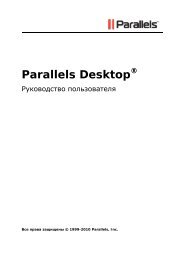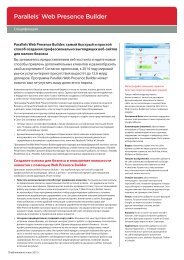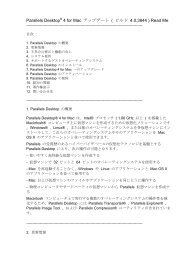[PDF] Parallels Server 5 Bare Metal
[PDF] Parallels Server 5 Bare Metal
[PDF] Parallels Server 5 Bare Metal
You also want an ePaper? Increase the reach of your titles
YUMPU automatically turns print PDFs into web optimized ePapers that Google loves.
Managing Resources<br />
• Guarantee. The amount of memory a virtual machine is guaranteed to get on demand. If the<br />
virtual machine requests more memory than is guaranteed, the memory allocation may fail (for<br />
example, if there is no free memory on the <strong>Parallels</strong> server at the moment). Moreover, if the<br />
guaranteed amount of memory of all virtual machines running on the server plus their overhead<br />
exceeds the reserved limit, you will not be able to start another virtual machine. By default, the<br />
guaranteed memory is calculated on the basis of RAM and video memory assigned to a virtual<br />
machine and is about a half of its total memory.<br />
Note: The overhead of a virtual machine depends on its configuration. For example, the overhead of a<br />
virtual machine that has 1024 MB of RAM, 2 CPUs, 256 MB of video memory, a network adapter, a<br />
sound card, and a USB controller and runs on modern hardware does not usually exceed 35-40 MB. To<br />
check the overhead of a running virtual machine, open the /proc/parallels/vm/VM_ID/meminfo<br />
file and look for the value of the Unreclaimable parameter. Keep in mind, however, that this value<br />
may change over time.<br />
• Limit. The maximum amount of memory a virtual machine is allowed to consume. The virtual<br />
machine cannot exceed this limit even if the <strong>Parallels</strong> server has a lot of free memory and the<br />
virtual machine requires this memory. By default, no limit is set for all newly created virtual<br />
machines, and any virtual machine may consume all free memory on the server.<br />
• Priority. The priority (from 1 to 100) that defines which virtual machine will get memory first. The<br />
higher the priority of a virtual machine, the more chances it has to get memory when the<br />
<strong>Parallels</strong> server has insufficient memory resources. By default, the priority is set to 50.<br />
• Ballooning. The maximum amount of memory the balloon driver in a virtual machine may<br />
allocate for its needs. Memory ballooning is a technique that allows your system to reclaim<br />
memory from virtual machines. To do this, a special balloon driver is loaded into each running<br />
virtual machine. When the system requires free memory but does not have any, it sends a<br />
command to the balloon driver in the virtual machine to increase its size. The balloon driver<br />
inflates by allocating the requested amount of memory in the virtual machine and then gives this<br />
memory to the system.<br />
By default, the balloon driver can allocate up to 60% of RAM set for a virtual machine. For<br />
example, if the amount of RAM for a virtual machine is set to 2 GB, the balloon driver can<br />
allocate the maximum of 1.2 GB of memory.<br />
To configure these quota control parameters for a specific virtual machine, you can use the -memquota<br />
parameter of the pctl set command. For example, the following command sets for<br />
the MyVM virtual machine the memory guarantee to 512 MB, the limit to 2 GB, the priority to 70,<br />
and the ballooning limit to 50% of RAM:<br />
# pctl set MyVM --memquota 512:2048:70:50<br />
Disable the memquota auto calculation.<br />
Set the memquota_min parameter to 512Mb.<br />
Set the memquota_max parameter to 1024Mb.<br />
Set the memquota_prio parameter to 70.<br />
Set the memquota_maxballoon parameter to 50.<br />
The VM has been successfully configured.<br />
To check that all parameters have been successfully set, use this command:<br />
# pctl list -i MyVM | grep memory_quota<br />
memory_quota min=512Mb max=2048Mb priority=70 maxballoon=50%<br />
147


![[PDF] Parallels Server 5 Bare Metal](https://img.yumpu.com/18850617/147/500x640/pdf-parallels-server-5-bare-metal.jpg)
![[PDF] Parallels Desktop® 7](https://img.yumpu.com/18852044/1/190x245/pdf-parallels-desktopr-7.jpg?quality=85)

![[PDF] Parallels Python API Reference](https://img.yumpu.com/18850615/1/190x245/pdf-parallels-python-api-reference.jpg?quality=85)








![[PDF] Parallels Python API Reference](https://img.yumpu.com/18850529/1/190x245/pdf-parallels-python-api-reference.jpg?quality=85)

